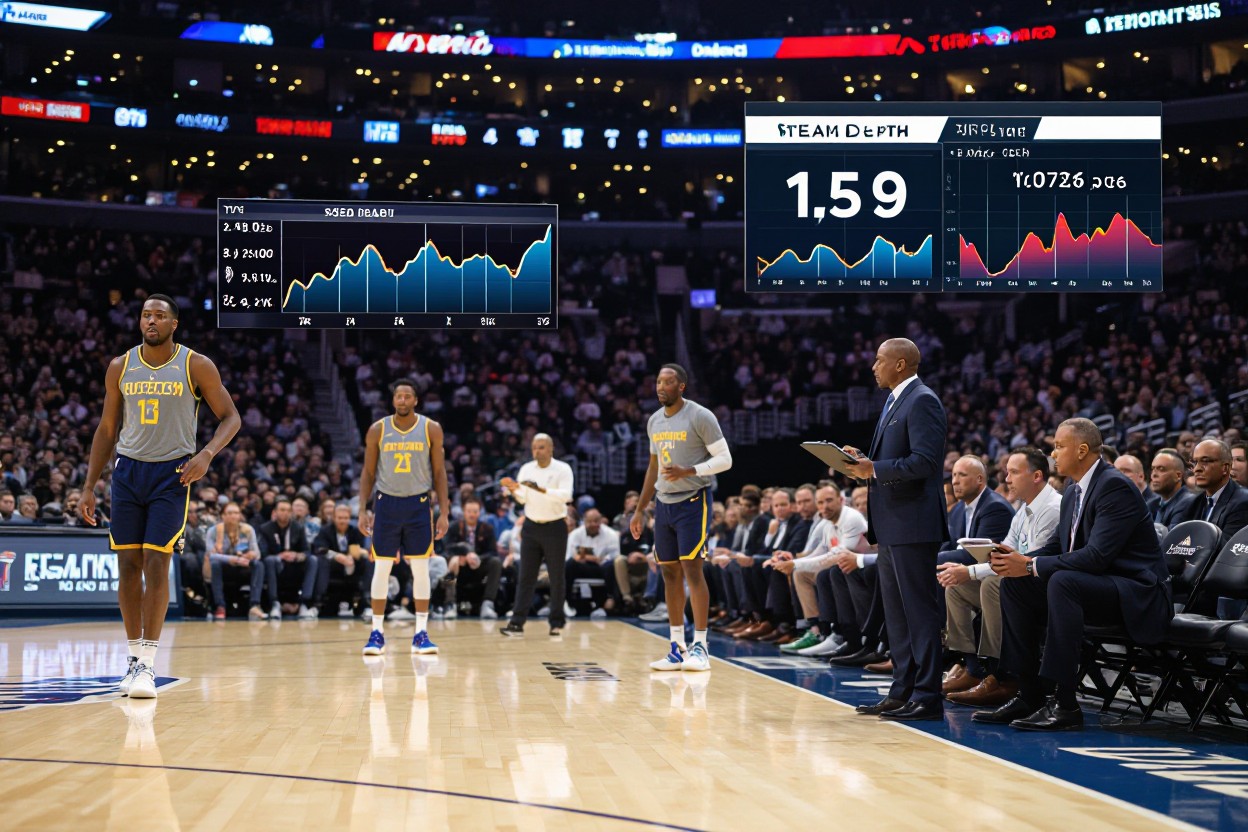Many NBA fans like you might overlook how team depth and player rotation can significantly impact your betting outcomes. When you understand how coaches manage minutes and utilize bench players, you gain insight into factors that affect game pace, player fatigue, and matchup advantages. Teams with strong depth may maintain high-energy play throughout, giving you an edge in predicting results or point spreads. Conversely, shallow rotations often lead to late-game declines that can surprise you. By mastering these nuances, you enhance your ability to place smarter, more informed bets.
The Crucial Role of Team Depth in NBA Strategy
Team depth determines how well a squad sustains performance throughout the grueling 82-game NBA season and high-stakes playoff series. A lineup loaded with reliable contributors beyond the starting five provides coaches the flexibility to manage minutes, adjust tactics, and maintain pressure on opponents. For example, the 2020 Lakers thrived with strong role players like Kentavious Caldwell-Pope and Alex Caruso stepping up, enabling stars to rest without sacrificing defense or scoring. Your bets should factor in how deep a roster is, especially during back-to-back games or injury-plagued stretches.
Examining Roster Composition: Starters vs. Role Players
Starters typically handle the bulk of minutes and carry the scoring load, but emerging role players can swing momentum with timely defense or three-point shooting. Teams like the Miami Heat excelled with “3-and-D” specialists coming off the bench, offering a spark that often changed game dynamics. Evaluating the balance between star talent and bench contributors provides insight into sustained team performance and potential overachievements during the season. Your analysis gains an edge by dissecting how coaches integrate role players in different lineups.
Analyzing the Impact of Bench Strength on Game Outcomes
Bench strength often translates into pivotal advantages, especially in close contests where second units control pace and energy shifts. The Milwaukee Bucks’ 2021 championship run highlighted the value of a potent bench with players like Bryn Forbes and Bobby Portis providing critical scoring bursts. Deep benches ensure starters can rest without dropping performance, which decreases fatigue-related mistakes late in the game. By closely tracking bench efficiency metrics, you can better predict when teams are likely to maintain leads or stage comebacks.
Digging deeper into bench performance statistics reveals tangible trends valuable for your betting strategy. Teams with bench units contributing over 35 points per game often outperform expectations, especially against squads reliant solely on starters. Additionally, advanced stats such as bench net rating and plus-minus during second-quarter spurts provide clues about momentum shifts. You can leverage this data to identify underdog teams with strong rotation players who might secure surprises, particularly in back-to-back scenarios where starter fatigue accumulates.
The Dynamics of Player Rotation and Its Betting Implications
Player rotations significantly shape game flow and outcomes, directly influencing betting angles like point spreads and over/unders. For example, deep rotations can sustain high-intensity defense late into the game, suppressing scoring opportunities and skewing totals under projections. Conversely, short rotations can lead to player fatigue, increasing turnover rates and defensive lapses, impacting point differentials. Understanding how rotations alter team pace and efficiency equips you with an edge, especially when sportsbooks may overlook subtle in-game adjustments made by coaches.
How Rotation Patterns Affect Player Performance
Rotation patterns often dictate a player’s rhythm and stamina on the court. Frequent substitutions for key players, such as limiting starter minutes to about 28-32 per game like the 2023 Warriors, preserve sharpness for crunch time. In contrast, heavy minute loads can degrade shooting percentages and defensive intensity, as witnessed by tired teams allowing late-game scoring runs. Spotting these usage trends helps you anticipate performance dips or peaks that influence prop bets on points, assists, or rebounds.
Evaluating Coaches’ Strategies: Matchups and Substitutions
Coaches tailor rotations to exploit opponent weaknesses, often shifting lineups to isolate matchup advantages. For example, deploying versatile defenders like Jrue Holiday against sharpshooters can disrupt rhythm and lower shooting efficiency. Adjusting substitutions after identifying fouling tendencies or foul trouble also changes player availability and team dynamics. Betting lines frequently lag behind these strategic tweaks, so tracking lineup shifts during games enhances your ability to predict momentum swings and final results.
Beyond just plugging holes, coaching rotation strategies often hinge on detailed scouting reports and situational analytics. Coaches may deploy smaller, faster lineups to accelerate pace against slower opponents or use veteran-heavy units during critical periods to minimize errors. Recognizing these deliberate adjustments offers you insight into expected game tempo and scoring patterns. For instance, when a coach opts for a defensive specialist over a high-usage scorer in the closing minutes, you can infer a probable reduction in scoring output, influencing live betting decisions.
Analyzing Statistical Trends: Depth, Rotations, and Betting Odds
Exploring the relationship between team depth and rotation strategies reveals significant patterns in how bookmakers adjust betting odds. Teams with deeper benches often demonstrate greater consistency in performance across back-to-back games, reducing volatility and improving your chances of winning wagers. For example, during the 2023 NBA season, teams that rested star players in favor of bench contributions saw fluctuations in odds that savvy bettors exploited. You’ll find that analyzing substitution patterns and bench minutes per game offers predictive insights into game outcomes and line movements.
Predictive Models: What Data Reveals About Team Depth
Advanced analytics show that teams maintaining a rotation involving at least 8 players tend to outperform betting market expectations in the long term. Models incorporating metrics like cumulative plus-minus ratings for bench players and usage rates during critical stretches highlight the positive impact of balanced depth. For instance, the Golden State Warriors often sustain high second-half scoring due to effective rotation depth, significantly influencing their over/under betting trends in late-season play.
Historical Betting Outcomes Linked to Rotation Decisions
Historical data reveals an undeniable connection between strategic rotation choices and betting results, with over 60% of underdog wins linked directly to effective bench utilization. Teams that adjusted rotations mid-game to leverage bench scoring bursts turned odds in their favor more often than those relying heavily on starters. The 2017 Cleveland Cavaliers’ championship run, powered largely by bench contributors like Richard Jefferson and Jordan Clarkson delivering key minutes, perfectly illustrates this trend’s impact on bettor value during playoff series.
Diving deeper, research spanning multiple NBA seasons shows that coaches who exhibit flexible rotation approaches—especially in managing fatigue during congested schedules—enable their teams to outperform sagging public expectations, leading to favorable spreads and total points outcomes. Your betting strategy can benefit by tracking these rotation shifts pre-game and in-play, correlating them with win probabilities that statistically outpace baseline market odds. Incorporating this nuanced understanding into your analysis helps refine picks beyond traditional box score metrics.
Betting Smart: Integrating Team Depth Analysis into Your Strategy
By drilling down into how a team’s rotation functions across the season, you gain an edge in spotting potential mismatches and value. Depth reveals how coaches adjust lineups during back-to-backs, injuries, or against specific opponents. Look beyond star players; bench strength often dictates late-game outcomes and can influence the flow and pace, which directly impacts point spreads and totals. Integrating this granular knowledge empowers you to identify promising bets that the broader market may overlook, especially when key contributors rotate unexpectedly or fatigue sets in.
Techniques for Identifying Value Bets Based on Roster Insights
Analyzing recent minutes distribution data reveals shifts in player roles that impact overall team efficiency. For example, increased bench usage by playoff-caliber teams often correlates to defensive lapses or offensive slowdowns that bookmakers may underestimate. Tracking patterns like a bench player averaging double-digit points in their last five games can highlight newly emerging threats. Combining your knowledge of depth charts with line movement can expose discrepancies where the odds haven’t caught up to underlying roster transformations, presenting lucrative value bets.
Timing Your Bets: Capitalizing on Late-Rotation News
Waiting until late lineups or injury news are announced can unlock significant betting advantages. Rosters frequently adjust minutes or active players mere hours before tip-off, especially in tight schedules or back-to-back scenarios. When a key role player is suddenly inactive, odds often shift slowly, leaving a window for sharp bettors. Monitoring reliable sources for last-minute updates lets you place bets that reflect the true team composition and rotation, effectively turning otherwise hidden developments into profitable opportunities.
Late-rotation news creates volatility that often catches the betting public off guard. For instance, if a starting guard is ruled out after warmups due to a minor injury, a backup might see an unprecedented usage spike, changing the dynamics of scoring and defense. Oddsmakers tend to adjust lines after public bets flood in, so moving swiftly post-announcement lets you exploit initial inefficient pricing. Your access to real-time updates and understanding of how individual absences cascade through a team’s rotation solidifies your capacity to identify and act on these high-value betting situations.
Expert Opinions: Insights from Analysts and Bettors
Analysts emphasize how deep benches grant coaches flexibility to exploit matchups and preserve starters, which often shifts momentum in tight games. Bettors who track rotation patterns gain an edge by anticipating lineup changes that impact pace and scoring. For example, teams like the Milwaukee Bucks have leveraged rotation consistency to maintain winning streaks, prompting oddsmakers to adjust spreads accordingly. Understanding how expert evaluators weigh depth provides you a nuanced view of how these factors translate into betting opportunities.
Perspectives from Professional Bettors on Depth and Rotation
Pro bettors often view rotation insights as a way to spot value bets overlooked by casual fans. Noticing when a star player rests a game, yet the bench maintains offensive efficiency, can reveal mismatched odds. Some professionals track historical performance of second units, revealing that teams with bench players averaging over 20 minutes per game tend to cover point spreads easier. Your ability to interpret these rotation subtleties can dramatically improve your bet selections and bankroll management.
The Future of NBA Betting: How Teams Adapt and Influence Odds
Adjustments like load management and strategic minute distribution challenge traditional betting models, forcing sportsbooks to refine algorithms constantly. Teams embracing advanced analytics to optimize rotations create unpredictable scenarios bettors must adapt to. The increasing transparency of lineup data through real-time reporting helps you anticipate shifts before sportsbooks fully price them in. Observing how these evolving strategies influence betting lines becomes a valuable skill you develop over time.
The emerging trend where franchises use extensive sports science resources to monitor player fatigue and optimize stamina reshapes how rotations are planned game by game. This, in turn, manifests as fluctuating player availability and minutes that sportsbooks might lag in accounting for, offering you lucrative windows for sharp bets. Additionally, as load management grows, more teams replicate patterns once unique to superteams like the Golden State Warriors, diffusing betting market predictability. Staying updated on these adaptations not only enhances your understanding of team dynamics but also positions you to capitalize on shifting odds before consensus catches up.
Conclusion
From above, you can see that team depth and rotation play a significant role in NBA betting outcomes. By understanding how coaches manage player minutes and the impact of bench strength, you can make more informed predictions. Teams with strong benches often maintain performance levels during back-to-back games or injury spells, which affects betting lines and odds. Paying attention to these factors helps you identify value bets and anticipate shifts in team dynamics, ultimately enhancing the accuracy of your NBA wagers.

